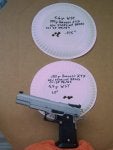A Ransom rest does indicate how accurate a pistol shoots with a given load. The Ransom rest is pretty much the standard by which all gunsmiths test their weapons for accuracy.
Two things are very important to achieve an accurate shot from a pistol:
1) mechanical accuracy and 2) practical accuracy
Mechanical accuracy is tested by shooting over sand bags, or better yet, a Ransom rest. The mechanical accuracy is only as good as the quality of the barrel and parts, the way they are fitted, and the quality of the ammunition used. For example, with an accurized .45, Winchester White box ammo may shoot to a 3" group at 50 yds, while 185 gr. Fed Match ammo may shoot sub two inch groups.
Practical accuracy of a gun is judged by how easy it is for someone to shoot the gun accurately. A highly accurized 1911 may shoot sub two inch groups from a rest, but if the trigger has an 8 pound pull, and is gritty with a lot of creep, the gun may not have good practical accuracy since the average shooter can not deliver proper trigger control with a horrible trigger pull, and may have a hard time shooting accurately. The weight, balance, the sight radius, type of sights, the trigger, and how comfortable the gun fits in a person's hand all contribute to practical accuracy.
I always strive to find the most accurate loads for my guns, so I experiment to find the optimal reload for each of my weapons. Also, I may have a mid range load and a self defense load that shoot to my expectations. Since I build my own guns from parts, I have been able to achieve both good mechanical and practical accuracy. The attached photo shows my last build, an STI 2011 hi-capacity pistol in .40 caliber, which will be used for concealed carry and also for USPSA Limited competition. The gun is both extremely accurate with my "major" caliber reloads, and the 3# trigger pull, with Bomar sights, makes it very good for practical accuracy as well. The photo shows the results from shooting over a sand bag rest at 25yds. I would expect this gun to shoot under 3" at 50 yards from a rest, which is not bad for an action shooting pistol....it was not intended to be used for precision shooting as in Bullseye competition.





